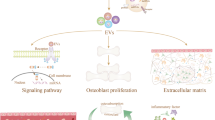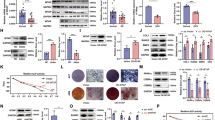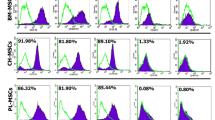Abstract
Systemic sclerosis (SSc), an autoimmune disease, may cause significant osteopenia due to activation of the IL4Rα/mTOR pathway. Mesenchymal stem cell transplantation (MSCT) can ameliorate immune disorders in SSc via inducing immune tolerance. However, it is unknown whether MSCT rescues osteopenia phenotype in SSc. Here we show that MSCT can effectively ameliorate osteopenia in SSc mice by rescuing impaired lineage differentiation of the recipient bone marrow MSCs. Mechanistically, we show that donor MSCs transfer miR-151-5p to the recipient bone marrow MSCs in SSc mice to inhibit IL4Rα expression, thus downregulating mTOR pathway activation to enhance osteogenic differentiation and reduce adipogenic differentiation. Moreover, systemic delivery of miR-151-5p is capable of rescuing osteopenia, impaired bone marrow MSCs, tight skin, and immune disorders in SSc mice, suggesting that miR-151-5p may be a specific target for SSc treatment. Our finding identifies a previously unrecognized role of MSCT in transferring miRNAs to recipient stem cells to ameliorate osteopenia via rescuing a non-coding RNA pathway.
Similar content being viewed by others
Log in or create a free account to read this content
Gain free access to this article, as well as selected content from this journal and more on nature.com
or
References
Gabrielli A, Avvedimento EV, Krieg T . Mechanisms of disease scleroderma. N Engl J Med 2009; 360:1989–2003.
Omair MA, Pagnoux C, McDonald-Blumer H, Johnson SR . Low bone density in systemic sclerosis. A systematic review. J Rheumatol 2013; 40:1881–1890.
Atteritano M, Sorbara S, Bagnato G, et al. Bone mineral density, bone turnover markers and fractures in patients with systemic sclerosis: a case control study. PLoS One 2013; 8:e66991.
Kilic G, Kilic E, Akgul O, Ozgocmen S . Increased risk for bone loss in women with systemic sclerosis: a comparative study with rheumatoid arthritis. Int J Rheum Dis 2016; 19:405–411.
Mugino H, Ikemura K . Progressive systemic sclerosis with spontaneous fracture due to resorption of the mandible: a case report. J Oral Maxillofac Surg 2006; 64:1137–1139.
Auluck A, Pai KM, Shetty C, Shenoi SD . Mandibular resorption in progressive systemic sclerosis: a report of three cases. Dentomaxillofac Radiol 2005; 34:384–386.
Souza RB, Borges CT, Takayama L, Aldrighi JM, Pereira RM . Systemic sclerosis and bone loss: the role of the disease and body composition. Scand J Rheumatol 2006; 35:384–387.
Barisic-Dujmovic T, Boban I, Adams DJ, Clark SH . Marfan-like skeletal phenotype in the tight skin (Tsk) mouse. Calcif Tissue Int 2007; 81:305–315.
Wynn TA . Fibrotic disease and the T(H)1/T(H)2 paradigm. Nat Rev Immunol 2004; 4:583–594.
Kodera T, McGaha TL, Phelps R, Paul WE, Bona CA . Disrupting the IL-4 gene rescues mice homozygous for the tight-skin mutation from embryonic death and diminishes TGF-beta production by fibroblasts. Proc Natl Acad Sci USA 2002; 99:3800–3805.
Chen C, Akiyama K, Wang D, et al. IL4Rα-mediated mTOR signaling determines mesenchymal stem cell lineage differentiation in fibrillin-1-mutant-induced osteopenia. J Exp Med 2014; 212:73–91.
Le Blanc K, Rasmusson I, Sundberg B, et al. Treatment of severe acute graft-versus-host disease with third party haploidentical mesenchymal stem cells. Lancet 2004; 363:1439–1441.
Sun L, Akiyama K, Zhang H, et al. Mesenchymal stem cell transplantation reverses multiorgan dysfunction in systemic lupus erythematosus mice and humans. Stem Cells 2009; 27:1421–1432.
Liang J, Gu F, Wang H, et al. Mesenchymal stem cell transplantation for diffuse alveolar hemorrhage in SLE. Nat Rev Rheumatol 2010; 6:486–489.
Liu X, Zheng P, Wang X, et al. A preliminary evaluation of efficacy and safety of Wharton's jelly mesenchymal stem cell transplantation in patients with type 2 diabetes mellitus. Stem Cell Res Ther 2014; 5:57.
Liang J, Li X, Zhang H, et al. Allogenic mesenchymal stem cells transplantation in patients with refractory RA. Clin Rheumatol 2012; 31:157–161.
Hatzistergos KE, Quevedo H, Oskouei BN, et al. Bone marrow mesenchymal stem cells stimulate cardiac stem cell proliferation and differentiation. Circ Res 2010; 107:913–922.
Sakaida I, Terai S, Yamamoto N, et al. Transplantation of bone marrow cells reduces CCl4-induced liver fibrosis in mice. Hepatology 2004; 40:1304–1311.
Yamada Y, Ueda M, Hibi H, Baba S . A novel approach to periodontal tissue regeneration with mesenchymal stem cells and platelet-rich plasma using tissue engineering technology: a clinical case report. Int J Periodontics Restorative Dent 2006; 26:363–369.
Kishk NA, Gabr H, Hamdy S, et al. Case control series of intrathecal autologus bone marrow mesenchymal stem cell therapy for chronic spinal cord injury. Neurorehabil Neural Repair 2010; 24:702–708.
Liu J, Han D, Wang Z, et al. Clinical analysis of the treatment of spinal cord injury with umbilical cord mesenchymal stem cells. Cytotherapy 2013; 15:185–191.
Chen X, Armstrong MA, Li G . Mesenchymal stem cells in immunoregulation. Immunol Cell Biol 2006; 84:413–421.
Scuderi N, Ceccarelli S, Onesti MG, et al. Human adipose-derived stem cells for cell-based therapies in the treatment of systemic sclerosis. Cell Transplant 2013; 22:779–795.
Ren G, Zhang L, Zhao X, et al. Mesenchymal stem cell-mediated immunosuppression occurs via concerted action of chemokines and nitric oxide. Cell Stem Cell 2008; 2:141–150.
Choi H, Lee RH, Bazhanov N, Oh JY, Prockop DJ . Anti-inflammatory protein TSG-6 secreted by activated MSCs attenuates zymosan-induced mouse peritonitis by decreasing TLR2/NF-kappaB signaling in resident macrophages. Blood 2011; 118:330–338.
Meisel R, Zibert A, Laryea M, Gobel U, Daubeber W, Dilloo D . Human bone marrow stromal cells inhibit allogeneic T-cell responses by indoleamine 2,3-dioxygenase-mediated tryptophan degradation. Blood 2004; 103:4619–4621.
Nemeth K, Leelahavanichkul A, Yuen PS, et al. Bone marrow stromal cells attenuate sepsis via prostaglandin E(2)-dependent reprogramming of host macrophages to increase their interleukin-10 production. Nat Med 2009; 15:42–49.
Akiyama K, Chen C, Wang D, et al. Mesenchymal-stem -cell-induced immunoregulation involves FAS-ligand-/FAS-mediated T cell apoptosis. Cell Stem Cell 2012; 10:544–555.
Chen C, Akiyama K, Yamaza T, et al. Telomerase governs immunomodulatory properties of mesenchymal stem cells by regulating FAS ligand expression. EMBO Mol Med 2014; 6:322–334.
Hayes J, Peruzzi PP, Lawler S . MicroRNAs in cancer: biomarkers, functions and therapy. Trends Mol Med 2014; 20:460–469.
Thery C, Amigorena S, Raposo G, Clayton A . Isolation and characterization of exosomes from cell culture supernatants and biological fluids. Curr Protoc Cell Biol 2006; Chapter 3:Unit3.22.
Dreux M, Garaigorta U, Boyd B, et al. Short-range exosomal transfer of viral RNA from infected cells to plasmacytoid dendritic cells triggers innate immunity. Cell Host Microbe 2012; 12:558–570.
Li J, Liu K, Liu Y, et al. Exosomes mediate the cell-to cell transmission of IFN-α-induced antiviral activity. Nat Immunol 2013; 14:793–803.
Luga V, Zhang L, Viloria-Petit AM, et al. Exosomes mediate stromal mobilization of autocrine Wnt-PCP signaling in breast cancer cell migration. Cell 2012; 151:1542–1556.
Boelens MC, Wu TJ, Nabet BY, et al. Exosome transfer from stromal to breast cancer cells regulates therapy resisitance pathways. Cell 2014; 159:499–513.
Liu S, Liu D, Chen C, et al. MSC transplantation improves osteopenia via epigenetic regulation of Notch signaling in lupus. Cell Metab 2015; 22:606–618.
Liu Y, Wang L, Liu S, et al. Transplantation of SHED prevents bone loss in the early phase of ovariectomy-induced osteoporosis. J Dent Res 2014; 93:1124–32.
Ono M, Kosaka N, Tominaga N, et al. Exosomes from bone marrow mesenchymal stem cells contain a microRNA that promotes dormancy in metastatic breast cancer cells. Sci Signal 2014; 7:ra63.
Baglio SR, Rooijers K, Koppers-Lalic D, et al. Human bone marrow- and adipose-mesenchymal stem cells secrete exosomes enriched in distinctive miRNA and tRNA species. Stem Cell Res Ther 2015; 6:127.
Wang B, Yao K, Huuskes BM, et al. Mesenchymal stem cells deliver exogenous microRNA-let7c via exosomes to attenuate renal fibrosis. Mol Ther 2016; 24:1290–1301.
Soifer HS, Rossi JJ, Saetrom P . MicroRNAs in disease and potential therapeutic applications. Mol Ther 2007; 15:2070–2079.
Witwer KW, Buzas EI, Bemis LT, et al. Standardization of sample collection, isolation and analysis methods in extracellular vesicle research. J Extracell Vesicles 2013; 2:jev.v2i0.20360.
Ostrowski M, Carmo NB, Krumeich S, et al. Rab27a and Rab27b control different steps of the exosome secretion pathway. Nat Cell Biol 2010; 12:19–30.
Nauta AJ, Fibbe WE . Immunomodulatory properties of mesenchymal stem cells. Blood 2007; 110:3499–3506.
Uccelli A, Moretta L, Pistoia V . Mesenchymal stem cells in health and disease. Nat Rev Immunol 2008; 8:726–736.
Bernardo ME, Locatelli F, Fibbe WE . Mesenchymal stromal cells. Ann NY Acad Sci 2009; 1176:101–117.
Maria AT, Toupet K, Bony C, et al. Antifibrotic, Antioxidant, and immunomodulatory effects of mesenchymal stem cells in HOCl-induced systemic sclerosis. Arthritis Rheumatol 2016; 68:1013–1025.
Maria AT, Toupet K, Maumus M, et al. Human adipose mesenchymal stem cells as potent anti-fibrosis for systemic sclerosis. J Autoimmun 2016; 70:31–39.
Wang D, Feng X, Lu L, et al. A CD8 T cell/indoleamine 2,3-dioxygenase axis is required for mesenchymal stem cell suppression of human systemic lupus erythematosus. Arthritis Rheumatol 2014; 66:2234–2245.
Golpanian S, Wolf A, Hatzistergos KE, Hare JM . Rebuilding the damaged heart: mesenchymal stem cells, cell-based therapy, and engineered heart tissue. Physiol Rev 2016; 96:1127–1168.
Mastro-Martinez I, Perez-Suarez E, Melen G, et al. Effects of local administration of allogenic adipose tissue-derived mesenchymal stem cells on functional recovery in experimental traumatic brain injury. Brain Inj 2015; 29:1497–1510.
Montecalvo A, Larregina AT, Shufesky WJ, et al. Mechanism of transfer of functional microRNAs between mouse dentritic cells via exosomes. Blood 2012; 119:756–766.
Xin H, Li Y, Cui Y, Yang JJ, Zhang ZG, Chopp M . Systemic administration of exosomes released from mesenchymal stromal cells promote functional recovery and neurovascular plasticity after stroke in rats. J Cereb Blood Flow Metab 2013; 33:1711–1715.
Li T, Yan Y, Wang B, et al. Exosomes derived from human umbilical cord mesenchymal stem cells alleviate liver fibrosis. Stem Cell Dev 2013; 15:845–854.
Lai RC, Chen TS, Lim SK . Mesenchymal stem cell exosome: a novel stem cell therapy for cardiovascular disease. Regen Med 2011; 6:481–492.
Yeo RW, Lai RC, Zhang B, et al. Mesenchymal stem cell: an efficient mass producer of exosomes for drug delivery. Adv Drug Deliv Rev 2013; 65:336–341.
Ciechomska M, van Laar JM, O'Reilly S . Emerging role of epigenetics in systemic sclerosis pathogenesis. Genes Immun 2014; 15:433–439.
Jimenes SA, Piera-Velazquez S . Potential role of human-specific genes, human-specific microRNAs and human-specific non-coding regulatory RNAs in the pathogenesis of systemic sclerosis and Sjogern's syndrome. Autoimmun Rev 2013; 12:1046–1051.
Li Y, Huang J, Guo M, Zuo X . MicroRNAs regulating signaling pathways: potential biomarkers in systemic sclerosis. Genomics Proteomics Bioinformatics 2015; 13:234–241.
Clark EA, Kalomoiris S, Nolta JA, Fierro FA . Concise review: microRNA function in multipotent mesenchymal stem cells. Stem Cells 2014; 32:1074–1082.
Li CJ, Cheng P, Liang MK, et al. MicroRNA-188 regulates age-related switch between osteoblast and adipocyte differentiation. J Clin Invest 2015; 125:1509–1522.
Broderick JA, Zamore PD . MicroRNA therapeutics. Gene Therapy 2011; 18:1104–1110.
Bonci D, Coppola V, Musumeci M, et al. The miR15a-miR16-1 cluster controls prostate cancer by targeting multiple oncogenic activities. Nat Med 2008; 14:1271–7.
Zhu H, Guo ZK, Jiang XX, et al. A protocol for isolation and culture of mesenchymal stem cells from mouse compact bone. Nat Protoc 2010; 5:550–560.
Soleimani M, Nadri S . A protocol for isolation and culture of mesenchymal stem cells from mouse bone marrow. Nat Protoc 2009; 4:102–106.
Miura M, Miura Y, Padilla-Nash HM, et al. Accumulated chromosomal instability in murine bone marrow mesenchymal stem cells leads to malignant transformation. Stem Cells 2006; 24:1095–1103.
Boregowda SV, Krishnappa V, Chambers JW, et al. Atmospheric oxygen inhibits growth and differentiation of marrow-derived mouse mesenchymal stem cells via a p53-dependent mechanism: implications for long-term culture expansion. Stem Cells 2012; 30:975–987.
Phinney DG . Functional heterogeneity of mesenchymal stem cells: implications for cell therapy. J Cell Biochem 2012; 113:2806–2812.
Acknowledgements
This work was supported by grants from National Institute of Dental and Craniofacial Research, National Institutes of Health, Department of Health and Human Services (R01DE017449 and R01DE019932 to SS and K99DE025915 to CC), an NIH NIAMS fellowship (T32AR007442), and an Schoenleber Pilot Research Grant from University of Pennsylvania School of Dental Medicine. Clinical studies were supported by grants from the China Major International (Regional) Joint Project (81120108021 to LS) and Jiangsu Province Major Research and Development Program (BE 2015062 to LS). ClinicalTrials.gov Identifier: NCT00962923.
Author information
Authors and Affiliations
Corresponding authors
Additional information
( Supplementary information is linked to the online version of the paper on the Cell Research website.)
Supplementary information
Supplementary information, Table S1
miRNA hits on IL4Rα (PDF 1954 kb)
Supplementary information, Table S2
SSc Patients and Normal Controls Information (PDF 360 kb)
Supplementary information, Figure S1
Does responses of miR151-5p mimic and inhibitor. (PDF 92 kb)
Supplementary information, Figure S2
miR-151-5p characterization. (PDF 1465 kb)
Supplementary information, Figure S3
miR-151-5p inhibitor regulated human BMMSC lineage differentiation. (PDF 3461 kb)
Supplementary information, Figure S4
miR-151-5p mimic rescued IL4-induced lineage alteration in hMSCs. (PDF 5457 kb)
Supplementary information, Figure S5
Exosome-mediated miR-151-5p transfer. (PDF 274 kb)
Supplementary information, Figure S6
Blockage of Rab27a by siRNA reduced therapeutic effects of MSCT in Tsk/+ mice. (PDF 4635 kb)
Supplementary information, Figure S7
miR151-5p overexpression in EVs reduced EV dosage for disease treatment in Tsk/+ mice. (PDF 4260 kb)
Supplementary information, Figure S8
Ad-miR-151 treatment inhibited TH2 cell differentiation in Tsk/+ mice. (PDF 634 kb)
Supplementary information, Figure S9
Ad-miR-151 treatment ameliorated T cell infiltration and autoimmune index in Tsk/+ mice. (PDF 2988 kb)
Supplementary information, Figure S10
Ad-miR151 treatment rescued IL4-inhibited osteoclastogenesis. (PDF 808 kb)
Supplementary information, Figure S11
Schematic diagram of miR-151-5p transfer from donor MSCs to Tsk/+ recipient MSCs to regulate IL4Rα/mTOR signaling. (PDF 186 kb)
Supplementary information, Figure S12
Quantification and Characterization of EVs. (PDF 81 kb)
Rights and permissions
About this article
Cite this article
Chen, C., Wang, D., Moshaverinia, A. et al. Mesenchymal stem cell transplantation in tight-skin mice identifies miR-151-5p as a therapeutic target for systemic sclerosis. Cell Res 27, 559–577 (2017). https://doi.org/10.1038/cr.2017.11
Received:
Revised:
Accepted:
Published:
Issue date:
DOI: https://doi.org/10.1038/cr.2017.11
Keywords
This article is cited by
-
Improvement in long-term survival with mesenchymal stem cell transplantation in systemic sclerosis patients: a propensity score-matched cohort study
Stem Cell Research & Therapy (2025)
-
The stromal vascular fraction mitigates bleomycin-induced skin fibrosis in mice by modulating vascular lesions and secreting antifibrotic factors at different stages of disease
Stem Cell Research & Therapy (2025)
-
Mesenchymal Stromal Cell-Based Therapy: A Promising Approach for Autoimmune Diseases
Clinical Reviews in Allergy & Immunology (2025)
-
Stem cell-based therapy for fibrotic diseases: mechanisms and pathways
Stem Cell Research & Therapy (2024)
-
m6A-dependent mature miR-151-5p accelerates the malignant process of HNSCC by targeting LYPD3
Molecular Biomedicine (2024)



